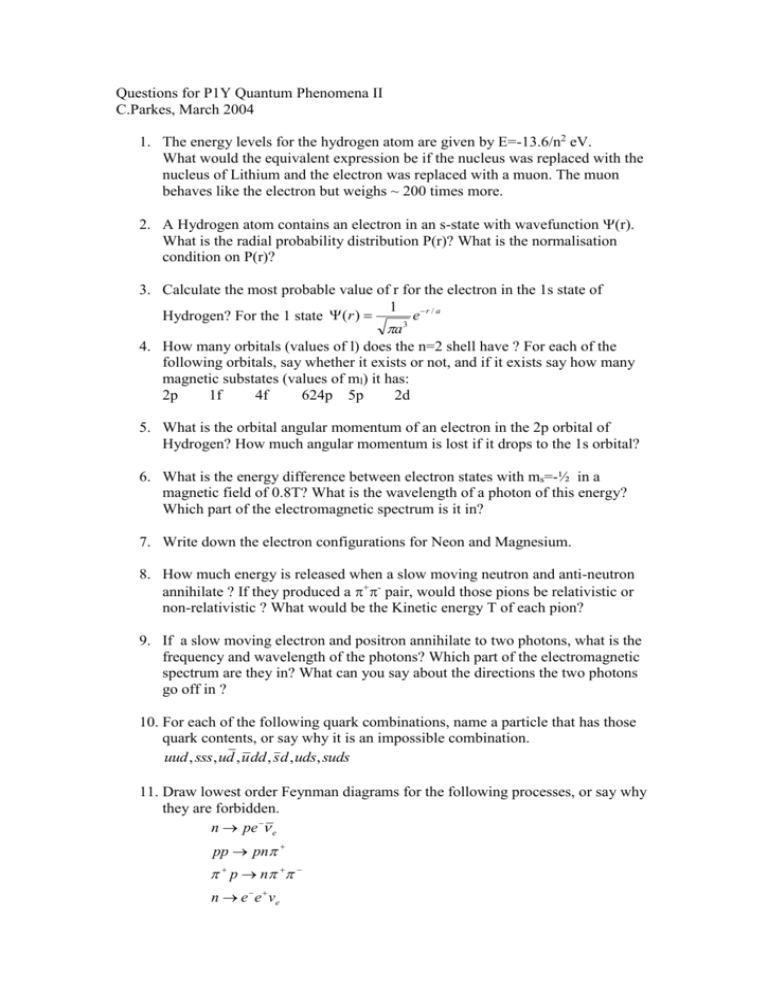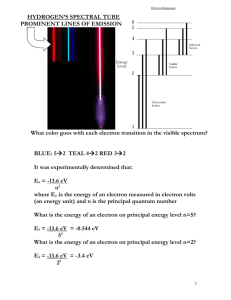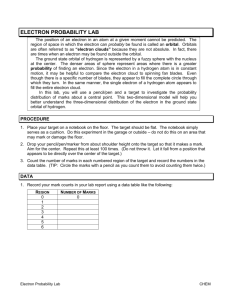Questions for P1Y Quantum Phenomena II
advertisement

Questions for P1Y Quantum Phenomena II C.Parkes, March 2004 1. The energy levels for the hydrogen atom are given by E=-13.6/n2 eV. What would the equivalent expression be if the nucleus was replaced with the nucleus of Lithium and the electron was replaced with a muon. The muon behaves like the electron but weighs ~ 200 times more. 2. A Hydrogen atom contains an electron in an s-state with wavefunction (r). What is the radial probability distribution P(r)? What is the normalisation condition on P(r)? 3. Calculate the most probable value of r for the electron in the 1s state of 1 r / a e Hydrogen? For the 1 state (r ) a 3 4. How many orbitals (values of l) does the n=2 shell have ? For each of the following orbitals, say whether it exists or not, and if it exists say how many magnetic substates (values of ml) it has: 2p 1f 4f 624p 5p 2d 5. What is the orbital angular momentum of an electron in the 2p orbital of Hydrogen? How much angular momentum is lost if it drops to the 1s orbital? 6. What is the energy difference between electron states with ms=-½ in a magnetic field of 0.8T? What is the wavelength of a photon of this energy? Which part of the electromagnetic spectrum is it in? 7. Write down the electron configurations for Neon and Magnesium. 8. How much energy is released when a slow moving neutron and anti-neutron annihilate ? If they produced a +- pair, would those pions be relativistic or non-relativistic ? What would be the Kinetic energy T of each pion? 9. If a slow moving electron and positron annihilate to two photons, what is the frequency and wavelength of the photons? Which part of the electromagnetic spectrum are they in? What can you say about the directions the two photons go off in ? 10. For each of the following quark combinations, name a particle that has those quark contents, or say why it is an impossible combination. uud , sss , ud , u dd , s d , uds, suds 11. Draw lowest order Feynman diagrams for the following processes, or say why they are forbidden. n pe e pp pn p n n e e ve 12. The following particles are produced in collisions at an electron positron particle accelerator: ,,+,,n. Explain, including a Feynman diagram, how each particle may have been produced and explain which elements of a modern particle physics detector would have observed it. 13. A Galaxy in the constellation Pisces is 5210 Mly from the earth. Use Hubble’s law to calculate the speed at which this galaxy is receding from the earth. How would the wavelength of the emitted light differ if the galaxy was not moving? 14. Given that the ratio of protons to neutrons at t=1s was approximately 4.5, estimate the ratio of protons to neutrons in the universe three minutes after the big bang. Illustrate your answer with a Feynman diagram to illustrate proton decay. The mean lifetime of the neutron is 887 seconds. 15. Given that the ratio of protons to neutrons at the time nucleosynthesis occurred was approximately seven to one, estimate the relative abundance by mass of Hydrogen and Helium. You may neglect the effect of H and Helium isotopes or Lithium formation in your calculation. How were all the other elements created ? 16. The universe is filled with blackbody spectrum radiation with a temperature of 2.73K. What is the origin of this radiation ? What is the corresponding peak wavelength ?









